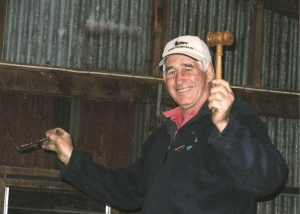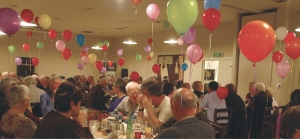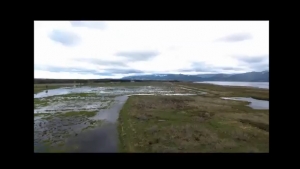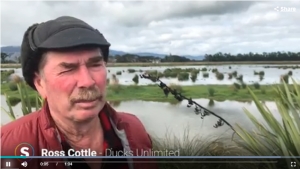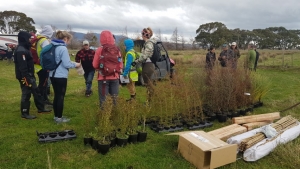Super User
John Dermer – the ultimate Farm Forrester
The Dermers also grow cereal cash crops, do bull finishing, lamb finishing and run a small ewe breeding flock. Oh – and there are turkey’s that have the freedom of the farm. Diny also maintains a large number of hens, and several Peking ducks. Diny keeps the garden in order and has several citrus trees including an orange, grapefruit and several lemon trees always covered in fruit. They do well around the house. There are also several camellias. But Diny is also the extra farm hand, and is often to be found out on the tractor or helping in the wool shed.
DUNZ Annual Conference
Attendees from as far north as Auckland gathered at Brackenridge near Martinborough, Wairarapa, for DU’s annual conference and AGM. The conference included a trip to the Wairio Wetland on the eastern shores of Lake Wairarapa to catch-up on restoration progress. Delegates saw the results of recent earthworks to create a 1.2 kilometre bund wall
which has increased the open water area at the wetland providing ideal waterfowl habitat.
Those interested can check out DU’s activities on www.ducks.org.nz or better still visit Wairio Wetland on Parera Road, just south of Kahutara southern Wairarapa.
Jim Law
AGM August - at a great venue
Conference at Brackenridge Country Retreat & Spa, Martinborough, Wairarapa, Friday August 1 to Sunday August 3.
A three minute drive from the Martinborough Square, Brackenridge sits within view of
the iconic Haurangi ranges. Reminiscent of
early New Zealand station dwellings yet with welcoming stylish interiors, the cottages and
studios offer relaxing accommodation. The main reception venue with open fires and covered
verandas complete the picture.
Brackenridge can accommodate up to 64
guests in a mix of two (up to 4 guests) and four bedroom (up to 8 guests) cottages and studios. They have been very generous to DUNZ and
continental breakfast provisions plus free range eggs, plus full use of the gym, spa pool and 20m indoor heated pool.
The Spa Brackenridge is open all weekend for appointments – bookings are essential.
At this stage we are planning to have a BBQ Dinner Friday evening for those who can get there.
On Saturday the actual AGM in the morning is followed by a bus trip to Wairio wetlands with lunch at Lake Ferry Hotel.
That evening is Buffet dinner at Brackenridge
On Sunday we have organised several speakers. I visited the facilities in January and they are wonderful.
Request:
If anyone has auction items they purchased at a previous DU dinner and no longer like or want, please feel free to recycle them back into the organisation.
Or if you have other items suitable for the
auction, just email me and I will organise
someone to pick them up – This email address is being protected from spambots. You need JavaScript enabled to view it. Many thanks
Jan Abel, Administration
From the President
The late spring - summer across most of New Zealand has been significantly wetter than last year and this is good for wetlands and waterfowl with greater survival of young birds.
Although most of the large permanent lakes (Waihola, Ellesmere, Wairarapa, Hatuma and Whangape) still exist, many of them suffer from water quality problems which reduce their productivity in terms of plants, birds and fish. The ephemeral wetlands around their margins are also under pressure. The excellent work of DU and other organisations is going some way to address the habitat issues but there is much more to do. Much of the DU effort is supported by donations and subsidies which we are extremely grateful for.
There are also good results being achieved from many of the whio and pateke projects around the country which DU has supported. With these endangered species there often is sufficient habitat but introduced mammalian predators play a major role in limiting numbers and even causing local extinctions. Where ongoing predator control is carried out 300 percent increase in whio numbers is regularly being recorded.
Our AGM is being held near Martinborough in the Wairarapa on August 1-3 and an interesting programme and field trip is being organised. Please mark your diaries. (See information page 2)
Look forward to seeing you all then.
John Cheyne
Wairio Wetland Drone Tour
Drone Tour of the Wairio wetlands
Watch the Drone Tour of the wetlands that was created by the Victoria University Research team
Drone view flying over the Wairio Complex
Video interview
DU President - Video Interview
Well-known journalist, Piers Fuller, interviews DUNZ President Ross Cottle about the history of the celebrated Wairio Wetland development
You can view the video interview here
Classroom in a Wetland
Victoria University’s classroom in a wetland!
Five years ago, Victoria University Wellington students planted a swathe of nursery trees in the Wairio Wetland.
This landmark wetland habitat was created in the late 1980s by Ducks Unlimited in Collaboration with the Department of Conservation (DOC).
Last week the Victoria University biodiversity team were back. Stephen Hartley and his team were armed with over 300 specimen trees (Kahikatea, Totara, Tawaki (or Swamp) Maire & Cabbage)- sourced thanks to a $2000 grant from DOC - to continue their comparative research into cost effective restoration processes by adding these trees as infill planting.
The cold but enthusiastic University team were supported by members of Ducks Unlimited and DOC.
Our wetlands
The international theme of World Wetlands Day this year (2014) is “Wetlands and Agriculture: Partners for Growth”.
For millennia, wetlands have been used directly for agriculture and for supplying food, fuel and fibre to support lives and livelihoods.
Wetlands continue to play an essential role in supporting modern agriculture. They provide water storage, flood buffering, nutrient removal, water purification and erosion control. Sustainable practices which support both agriculture and healthy wetlands are therefore coming to the fore.
Australia was one of the first countries to sign the Convention on Wetlands of International Importance (more commonly known as the Ramsar Convention), and in 1974 designated the world’s first Ramsar site at Cobourg Peninsula in the Northern Territory. They beat
us by two years.
New Zealand became a party to the Ramsar Convention on Wetlands in December 1976 and has listed six sites covering almost 55,112 hectares in the List of Wetlands of International Importance.
They are:
- Whangamarino, Waikato
- Kopuatai Peat Dome, Waikato
- Firth of Thames, Waikato
- Manawatu River Estuary, Manawatu
- Farewell Spit, Nelson
- Awarua Wetland/Waituna Lagoon,Southland.
Trapping at Boggy/Wairio
Trapping at Boggy/Wairio in April by Steve Playle resulted in the following critters recorded - 4 cats, 1 ferret, 9 rats, 3 mice, 1 magpie and 17 hedgehogs.
The grand total came to 15 cats, 36 ferrets, 1 stoat, 9 weasels, 130 hedgehogs, 46 rats, 21 mice, 3 magpies, 1 harrier hawk and 1 rabbit.
Steve also saw a Bittern in Boggy Pond down where the culvert pipes are beside the Boggy stop bank. That photo is on the front cover.
Steve has since put in other trap sites along the new track to the viewing hide out by the spillway.
Water birds love Champion wetland
The JK Donald Reserve featured in the April issue of Flight, celebrating their becoming the National Rural Wetland Champion 2014.
Jane Donald’s daughter Paula Gillett took these photos a week before duck shooting.
They are taken in the JK Donald Reserve on the North Eastern side of Lake Wairarapa.
The Lake is a very popular shooting area where Fish & Game allocate Maimai sites on and around the Reserve.
Photos: Paula Gillett

